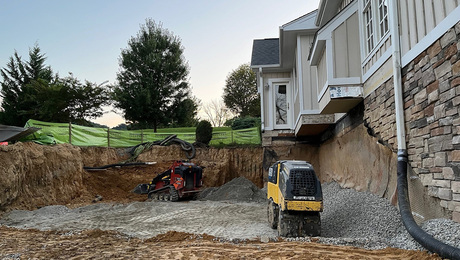Rebuilding a slate patio. Originally the slate was just laid down directly on the soil. I want to reset into a more stable base (and minimize weeds). Crusher dust, gravel, concrete? Thanks in advance for the advice.
Jim
Rebuilding a slate patio. Originally the slate was just laid down directly on the soil. I want to reset into a more stable base (and minimize weeds). Crusher dust, gravel, concrete? Thanks in advance for the advice.
Jim

Listeners write in about ambitious projects and sinking patios before asking questions about old house specialists, attic headroom, and home shops.

"I have learned so much thanks to the searchable articles on the FHB website. I can confidently say that I expect to be a life-long subscriber." - M.K.
Get home building tips, offers, and expert advice in your inbox

Dig into cutting-edge approaches and decades of proven solutions with total access to our experts and tradespeople.
Start Free Trial Now
Get instant access to the latest developments in green building, research, and reports from the field.
Start Free Trial Now
Dig into cutting-edge approaches and decades of proven solutions with total access to our experts and tradespeople.
Start Free Trial NowGet instant access to the latest developments in green building, research, and reports from the field.
Start Free Trial Now© 2025 Active Interest Media. All rights reserved.
Fine Homebuilding receives a commission for items purchased through links on this site, including Amazon Associates and other affiliate advertising programs.
Get home building tips, offers, and expert advice in your inbox
Become a member and get instant access to thousands of videos, how-tos, tool reviews, and design features.
Start Your Free TrialGet complete site access to expert advice, how-to videos, Code Check, and more, plus the print magazine.
Already a member? Log in
Replies
Pull the slate an remove all organics (topsoil) until you get to the inorganic subsoil.
Remove enough subsoil so you can have 4-8 inches of compacted base beneath the slate. Less base if excellent drainage, more base if water drainage may be problematic.
Grade the subsoil for pitch if required. Add a perimeter footing if required to contain the base and anchor the perimeter slate.
Again, if water may be a problem, you can add pitched perforated piping on top of the subsoil to carry away water. Plan for the piping when (and if) you form your perimeter footing.
Add base. I prefer stone dust (crusher dust) which is easy to place, grade, compacts fabulously, and drains well. Run a plate compactor over it after each 2-4" placement. I use a large 36" landscaping rake for the preliminary placing...you can set screed pipes to help you get a nicely pitched surface in a uniform plane.
Compact your first placement, then repeat.
After compacting, you can run the landscaping rake ove the compacted stonedust. It will show any high/low spots in your base. Scrape material from high spots to low. Recompact.
Set the stone, scraping some stonedust out from under the thicker slate, and using extra stonedust to build up th base a bit under the thinner slate so the walking surface is in plane.
Fire up the grill.
The stonedust drains well and can be used for vitrually all sites, and can easily repaired years from now if required. If water is not a problem, then you could construct a hard patio...mortar the slate over a concrete slab.